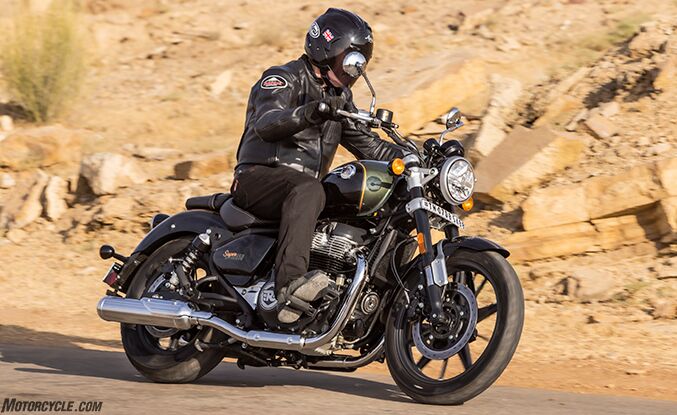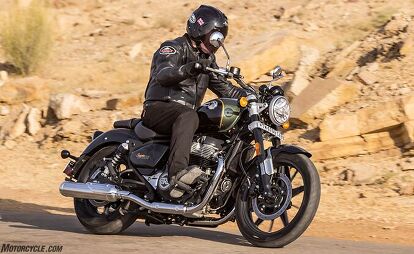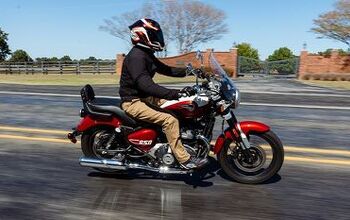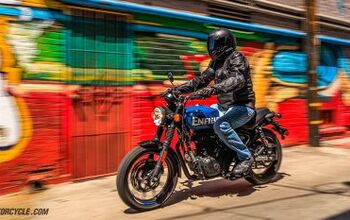2023 Royal Enfield Super Meteor 650 Review - First Ride
Riding Royal Enfield's cruisers through the Indian countryside
Five years on from the 2018 launch of its first ever twin-cylinder models to be made in India, since when over 400,000 examples of the Interceptor 650 and Continental GT 650 have been sold around the world, Royal Enfield has now added the first of a much-anticipated series of spinoff models to its range.
Unveiled at last November’s EICMA Milan Show and already in production at RE’s Chennai plant for global deliveries to commence in March, the Super Meteor 650 is available in two versions targeting different slices of the middleweight cruiser market. Named after Royal Enfield’s first 100mph model launched back in 1955, a 700cc breakthrough bike marketed as a go-anywhere mile-eater which was available for the first time from any manufacturer with its own array of optional touring equipment, these are both powered by the same air/oil-cooled eight-valve 648cc parallel-twin engine with central chain-driven SOHC equipping the Interceptor and Continental GT.
Developed at Royal Enfield’s UK Technology Centre at Bruntingthorpe, the company’s first twin-cylinder engine for the modern era measures 78 x 67.8 mm and carries a single gear-driven counterbalancer to reduce vibration. The 270º crankshaft is a forged one-piece item for extra strength and durability, and it’s so over-engineered you can well imagine it was built for eventual use in larger capacity motors – only not just yet. The fuel-injected engine employing a Bosch ECU and a pair of 34mm Mikuni throttle bodies produces a claimed 46.33 bhp at 7,250 rpm at the crankshaft, so is A2 license compliant in Europe, while maximum torque of 38.57 ft-lb is delivered at 5,650 revs – 400 rpm higher than on the earlier 650 twins. However, RE’s Chief Engineer Paolo Brovedani states there are no mechanical changes to the engine in the new models, only that the Super Meteor’s airbox and exhausts are all-new, which coupled with revised mapping for the ECU delivers a Cruiser-friendly wider spread of torque, with 80% of that peak grunt already available at just 2,500 rpm.
The unchanged six-speed transmission features a slip/assist clutch, with a heel-and-toe shifter pedal as standard on both Super Meteor variants, while the modest 9.5:1 compression ratio denotes a relatively low state of tune, most likely to ensure it runs well even on poor-quality fuel.
This now well-proven engine is carried as a fully-stressed component in an all-new composite steel duplex open cradle spine frame consisting of diverse forgings, investment castings, pressings, and extrusions which was developed at the UK Technology Centre in conjunction with RE subsidiary Harris Performance, and incorporates a new cylinder head mount for additional stiffness.
Showa has now replaced Gabriel as suspension supplier for Royal Enfield’s twins, and the Super Meteor comes with an upside-down fork for the first time on any RE model, albeit a non-adjustable 43mm Big Piston item carried at a 27.6° rake with 4.7 in. of trail, offering 4.7 in. of wheel travel. At the rear, the extruded steel swingarm delivering a rangy 59.0-in. wheelbase carries twin Showa shocks, with 5-step preload adjustment and 4.0 in. of travel. There’s a 19-inch forged aluminum front wheel and 16-inch rear, shod with Indian supplier CEAT’s new Zoom Cruz tubeless tires especially created for the Super Meteor duo, replacing the Pirellis fitted to the two existing Royal Enfield twin-cylinder models. Brovedani says his R&D test team, led by Aussie former 500GP racer Paul Young, has covered over one million kms. on test tracks, Belgian pavé cobblestones, and the highways, byways, towns, villages, and city centers of India, the UK, and Spain, in subjecting a model whose customers are likely to clock up serious mileage to the most rigorous of test programs.
A 29.1-in. seat height is quoted for both models, ensuring almost any rider can put both feet flat on the ground at rest, with forward footrests and a tall, wide touring-style handlebar featuring adjustable clutch and brake levers, despite the cable operation of the oil bath clutch. There’s a single round instrument cluster combining an analog speedo with an inset LCD digital panel showing gear selected, fuel level, time, odo and twin trips, and a USB socket located beneath the left side panel. Royal Enfield’s free-to-use TBT/Turn-by-Turn Tripper navigation pod developed in collaboration with Google and introduced two years ago on the Meteor 350, which links to the rider’s smartphone via Bluetooth, is included as standard for the first time on an RE twin-cylinder model. Sorry, but there’s no holder for your phone – you must buy one from the large selection of dedicated Super Meteor accessories.
Both a side stand that’s very easy to flip out while seated on the bike and an equally easy-access center stand come fitted as stock. All-new satin-chrome aluminum switch cubes are stylish and practical, despite looking slightly bland owing to the absence of any electronics other than EFI and ABS on a bike with a cable throttle. Hence devoid of ride by wire technology’s buttons and switches, they look well-made and substantial, while the ergonomically shaped barrel-profile handlebar grips incorporating the Royal Enfield logo nestle easily into your hands, as they’re specifically shaped to do. The LED headlamp is another first for Royal Enfield, matched to an LED rear light. Build quality is excellent with self-evident attention to detail, such as the way the oil cooler and hoses match up perfectly with the down tubes of the frame.
The fully-spec’d nature of the Super Meteor duo hasn’t bumped up their price unduly, despite these now being Royal Enfield’s top-of-the-range models. Taking ride-away UK list pricing (including 20% local tax) as the example, and incorporating a three-year unlimited mileage manufacturer’s warranty on both models, there are two groups of pricing for the Roadster variant, depending on the color chosen. [No official US pricing has been released at this time, and remember, there is no VAT Stateside. —EB] The Astral trio of Black, Green and Blue cost £6,799 ($8,425) on the road, with the Interstellar Grey and Green tints £200 ($247) more pricey at £6,999 ($8,673). Conversely, the Super Meteor 650 Tourer is available in two distinctive two-tone finishes, namely Celestial Red and Celestial Blue, each with a Cream tank top, costing £7,299 ($9,045) – again, on the road. This compares to current UK pricing of £6,199 to £6,699 ($7,682-$8,802) for the Interceptor and £6,399 to £6,899 ($7,930-$8,549) for the Continental GT, again depending on chosen paint scheme. Those keen prices for a well-equipped middleweight twin confirm that Royal Enfield is continuing its established tradition of offering a huge amount of motorcycle for the money.
OK, they look good, the pricing is great – but what are they like to ride? To discover that, I was asked to join a 40-strong press group from all over the globe invited to spend two days in India’s largest but most sparsely settled state, Rajasthan, which is as far west as you can go in the country, riding both bikes for more than 375mi over almost every single possible type of road condition. These ranged from town centers protected by viciously steep but frequently unmarked speed bumps, all choked with people and animals, cars, vans, trucks, and coaches in various states of decrepitude, and motorcycles, motorcycles, motorcycles everywhere, to narrow, winding rural roads which last saw a repair crew sometime in the last century. They went from well-surfaced but often traffic-clogged arterial highways lined with cattle which have taken on board the fact they’re impervious to harm, and thus wander freely around even fast four-lane toll roads without a care in the world, to deserted but beautifully made freeways out in the middle of nowhere, which compare well with anything built in the USA or Europe.
Those latter roads were undoubtedly built with the military in mind, since our riding base in the city of Jaisalmer was in western Rajasthan, as close as you can get 75 years on from the horrors of Partition, to the 1,800 mi.-long politically sensitive Pakistani border, one of the most heavily guarded international boundaries on the planet, which is only open to civilian traffic in one location a day’s ride away from our base. But on our second day traveling 280 mi. due east from Jaisalmer to the 16th century Khimsar Fort www.khimsar.com near Jodhpur (yes, where the horse riding pants come from) that’s been turned into a 68-bed luxury hotel, we rode through the Great Thar Desert in a high-speed caravan of Enfield twins running in line astern at speeds up to 100 mph. Passing just 2.5 mi. away from Pokhran, where India joined the Nuclear Weapons club in 1998, followed two weeks later by Pakistan, the great mile-eating capabilities of the Super Meteor were laid out in full as we hightailed it from west to east on a glorious winter morning with not a cloud in the sky. But I wished our test bikes had some heated grips fitted: Setting out at dawn at 46° F with no handguards, my fingers soon felt frostbitten at those speeds, before the sun got higher and the desert temperatures rose!
But this is a super-stable motorcycle that’ll be happy to cruise at high speeds all day long on German autobahns and the like, and that’s especially true of the Tourer version fitted with the really effective screen that Paolo Brovedani confirms was the subject of heaps of wind tunnel time to get just right, as evidenced by the Tourer’s total stability with no trace of a wobble round long, fast 80-mph sweepers. At 5’10” in height, I found myself completely protected from any windblast, with zero undue turbulence hitting my helmet and also no noise, nor any distortion looking through the screen. That possibly came about partly because the Tourer’s seat is quite different than the Standard bike’s, with a notably narrower stepover which allows you to tuck your knees in tighter to the tank (too bad it doesn’t have indentations in its flanks for them, like on the other 650 twins), and a shape which has you sitting more within the bike than on its sister model. Moreover, you’re seated a little less upright than on the Roadster variant, so leaning slightly forward as the handlebar invites you to do sees the base of your spine no longer in contact with the softer upholstery of the seat – Brovedani says the Tourer seat has a different density which makes it feel more luxurious. Nice.
But I’d spent the previous day at much lower speeds aboard a Standard model exploring the Rajasthan hinterland, visiting the ghost village of Kuldhara, whose inhabitants deserted it overnight in 1828 in protest against the steep taxes being levied on them by the rapacious ruler of Jaisalmer. Its deserted stone-built houses are often used today as a Bollywood movie backdrop, and to get there, we traveled southwest from Jaisalmer, to go as close as you can get to the Pakistan border without entering the minefields lining the frontier. The often bumpy roads provided an excellent test of the Super Meteor’s Showa suspension, with the settings for the raked-out, non-adjustable fork well chosen; even with the bike’s extra weight compared to an Interceptor or Continental GT, it didn’t bottom out via weight transfer under heavy braking descending into a dip in the road but kept on damping out road shock from the uneven surface.
The rear suspension was rather surprisingly even better, with the middle preload setting on the 5-way adjustable Showa shocks damping out the worst of the bumps – I could honestly feel the rear wheel following the road surface as the shocks compressed and released. They’re a considerable step up from the Gabriel units on the older 650 twins, whose twin-shock rear end’s much ‘drier’ damping makes them skip around a fair bit over bumps, underlining why progressive rate links and monoshock rear ends replaced such a format decades ago. That’s not the case with the Super Meteor’s super compliant Showas, whose well-chosen damping delivers enhanced ride quality over broken everyday road surfaces.
The Standard bike’s riding position has the pulled-back handlebar, mounted on curved 80mm risers cast into the upper triple clamp, combining with the mid-position forward-mounted footrests to deliver a reasonably relaxed, albeit pretty upright, stance. With the quite wide stepover and flatter-feeling seat compared to the Tourer, it seems you’re sitting more on the bike than in it, and pillion space is less spacious, also. I’d have liked to try a version with the footrests moved back 100mm/4 in or so: I reckon it might be a more rational riding position that way that’d be worthy of the true neo-Classic Roadster you get the impression is trying to escape from the Cruiser styling, but – hey, looks are important in this neck of the market, so put up with it. As it is, you must always use the heel-and-toe gearshift as designed to shift gear, because unless you have size 49 feet the gap between the left footrest and the toe lever is too great for you to shift up with your toe – you must remove your boot from the footrest to do so. The actual shift action is flawless, just that achieving it can be awkward.
As with the existing 650 models the Super Meteor’s twin-cylinder engine is definitely the star of the show in terms of riding satisfaction, for this is a middleweight motorcycle that thinks big. It’s been intelligently developed to be all things to all riders, so that the less experienced can ride around town all day in fourth gear, and the hyper-flexible engine will let them do so without any hiccups or transmission snatch. But at the other end of the performance scale, it’s a willing companion for a blast through the wide open roads of Rajasthan. You never forget that it’s ‘just’ a 650, because it doesn’t have the torque or power of a 900cc twin or even a 750 – but that’s OK, because the Royal Enfield motor invites you to work hard at making it go fast, as it will. Just make maximum use of the light action slip-assist clutch and smooth, precise gearshift to keep it revving, and you’ll be rewarded with quite impressive levels of performance. It’s a willing partner in making both new Super Meteors a ton of fun to ride hard.
The engine’s key asset is the great mapping of the Bosch ECU, especially the response from a closed throttle, which is ultra-smooth with no snatch or jerk. That’s especially so after braking deep into a turn and then getting on the throttle again to drive out of the apex – there’s just a liquid-smooth but no less immediate reaction to what your right hand is doing, and the response from closed to part or even full throttle is ideal. This again makes the bike an ideal mount for less experienced riders, as well as for use in India, where stop/start riding in heavy traffic is a fact of everyday life on two wheels. On the Super Meteor twins, you just twist and go, with a flawless pickup and a totally linear build of both power and torque.
The power delivery is impressive for a mid-sized motor, coupled with the abundant torque which is ideally spread throughout the rev range, providing a predictable and controllable surge of acceleration as soon as you twist the throttle to exit a turn. Top gear roll-on is impressive, too – running at three-quarter throttle at 75 mph in India on a deserted toll road in the overdrive sixth gear still leaves sufficient unused torque for the Super Meteor to surge forward noticeably if you crack the throttle wide open. For a 650cc motorcycle, this is a very autobahn-friendly device. The counterbalancer removes every trace of vibration all the way to that hard-action 7,500 rpm limiter, so that instead of the shake, rattle and roll of any parallel-twin, the Super Meteors were completely free of vibration, while the sound from the stock exhaust is a muted semi-angry burble that’s inevitably similar to a 90º V-twin, thanks to the 270º crank.
The operation of the single front twin-piston brake caliper and 320mm disc is just about adequate, with good feedback through the lever that’ll help you keep the ABS from kicking in too often on India’s dusty road surfaces. But both Super Meteors would definitely benefit from extra bite from the front brake, making you glad you’ve got the hefty 300mm rear brake that stops the bike better than its larger front partner. Thanks to the Super Meteor’s extra weight you must use both brakes hard to stop from any speed.
These new Royal Enfield Super Meteors are sufficiently different from each other that despite sharing the same mechanical platform, they’re essentially two distinct new models – mid-capacity Cruisers that are enjoyable to ride thanks to being blessed with a great engine, and super handling. And when the low price point is taken into consideration, then very likely Royal Enfield CEO Siddhartha Lal will have yet another hit on his hands. For since Triumph walked away from the middleweight retro twin-cylinder sector it had carved such a successful niche in, Royal Enfield has had that segment of the market to itself. So there is indeed nothing else available even remotely like these new 650cc Cruiser twins, and certainly nothing else giving comparable performance at such a low price – well, for the time being, at least, until a Chinese manufacturer like Voge or CFMoto decides to come after the Cruiser segment, however unlikely that might presently be.
Until then, Royal Enfield’s twin-cylinder range incorporating these latest two extensions has the field to itself in going back to the future by combining a modern SOHC middleweight parallel-twin engine design, with traditional styling and accessible performance. As Siddhartha Lal said in launching them, “These new Twins carry forward the Royal Enfield legacy into the 21st century. While in essence they retain old-school design and character, they have all the underpinnings of a modern machine, combining agility, usable power, excellent ergonomics, and style, all in an unintimidating manner. However, each is more than the sum of its parts – they’re great fun to ride and bring a smile on your face every single time. The engine has been designed to offer the right balance between power, torque, and usability, so as to ensure a smooth and unintimidating riding experience. They offer a broad spread of torque which makes the motorcycle easy to ride, without frequently shifting gears.”
After covering some serious distance aboard the latest two examples of this product philosophy during our Rajasthan Raid, I can’t argue with that.
2023 Royal Enfield Super Meteor 650 | |
|---|---|
| Engine | Air/oil-cooled parallel-Twin |
| Capacity | 648cc |
| Bore x stroke | 78.0 mm x 67.8 mm |
| Power | 46.4 hp at 7,250 rpm (claimed) |
| Torque | 38.6 lb-ft. at 5,650 rpm (claimed) |
| Compression ratio | 9.5:1 |
| Valvetrain | SOHC, 4 valves per cylinder |
| Fuel System | Multipoint sequential Bosch electronic fuel injection with 2 x 34mm Mikuni throttle bodies |
| Transmission | 6-speed |
| Final drive | Chain |
| Frame construction | Composite steel open cradle duplex spine frame with engine employed as fully stressed member |
| Front suspension | 43mm Showa Big Piston telescopic fork with 4.7-in. travel |
| Rear suspension | Box-section steel swingarm with 2 x Showa shocks, 4.0-in travel with 5-stage preload adjustment |
| Wheel castor | 4.7 in. |
| Steering head angle | 27.6° |
| Front Brake | 320 mm steel disc with twin-piston floating ByBre caliper and Bosch ABS |
| Rear Brake | 300 mm steel disc with twin-piston floating ByBre caliper and Bosch ABS |
| Front Wheel | 100/90-19 CEAT Zoom Cruz 57H on 2.50 in. forged aluminium wheel |
| Rear Wheel | 150/80-16 CEAT Zoom Cruz 71H on 4.50 in. forged aluminium wheel |
| Wheelbase | 59.0 inches |
| Seat height | 29.1 inches |
| Curb weight | 531 lb. with oil and 90% full fuel tank |
| Fuel tank capacity | 4.1 gallons |
Become a Motorcycle.com insider. Get the latest motorcycle news first by subscribing to our newsletter here.
A man needing no introduction, Alan Cathcart has ridden motorcycles since age 14, but first raced cars before swapping to bikes in 1973. During his 25-year racing career he’s won or been near the top in countless international races, riding some of the most revered motorcycles in history. In addition to his racing resume, Alan’s frequently requested by many leading motorcycle manufacturers to evaluate and comment on their significant new models before launch, and his detailed feature articles have been published across the globe. Alan was the only journalist permitted by all major factories in Japan and Europe to test ride their works Grand Prix and World Superbike machines from 1983 to 2008 (MotoGP) and 1988 to 2015 (World Superbike). Winner of the Guild of Motoring Writers ‘Pierre Dreyfus Award’ twice as Journalist of the Year covering both cars and bikes, Alan is also a six-time winner of the Guild’s ‘Rootes Gold Cup’ in recognition of outstanding achievement in the world of Motorsport. Finally, he’s also won the Guild’s Aston Martin Trophy in 2002 for outstanding achievement in International Journalism. Born in Wales, married to Stella, and father to three children (2 sons, 1 daughter), Alan lives in southern England half an hour north of Chichester, the venue for the annual Goodwood Festival of Speed and Goodwood Revival events. He enjoys classic cars and bikes, travel, films, country rock music, wine - and good food.
More by Alan Cathcart



































































































Comments
Join the conversation
One hell of a good review. Thanks for the visit to India.
Can you explain why the Royal Enfield (RE) 650cc engine is so flexible? It doesn't seem to matter what gear the RE is in the engine will cope very well without any snatching or signs of struggling. My Triumph T120 will not do as well, I have to constantly change gears and will have to change gears from 2nd to 3rd around town, getting into 4th around town is impossible.